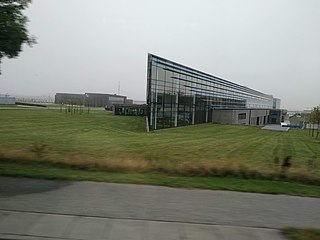
Vestas Wind Systems A/S is a Danish manufacturer, seller, installer, and servicer of wind turbines that was founded in 1945. The company operates manufacturing plants in Denmark, Germany, the Netherlands, Taiwan, India, Italy, Romania, the United Kingdom, Spain, Sweden, Norway, Australia, China, Brazil, Poland and the United States, and employs 29,000 people globally.
Doubly fed electric machines, also slip-ring generators, are electric motors or electric generators, where both the field magnet windings and armature windings are separately connected to equipment outside the machine.
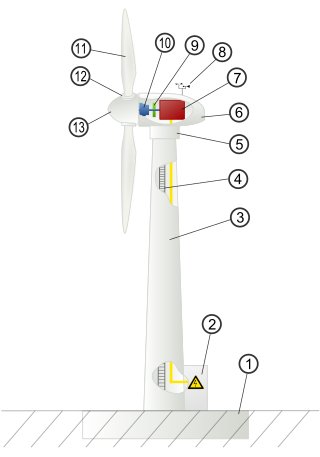
Wind turbine design is the process of defining the form and configuration of a wind turbine to extract energy from the wind. An installation consists of the systems needed to capture the wind's energy, point the turbine into the wind, convert mechanical rotation into electrical power, and other systems to start, stop, and control the turbine.

Spain is one of the countries with the largest wind power capacity installed, with over 27 GW in 2020. In 2013, it had become the first country in the world to have wind power as its main source of energy.
The tip-speed ratio, λ, or TSR for wind turbines is the ratio between the tangential speed of the tip of a blade and the actual speed of the wind, v. The tip-speed ratio is related to efficiency, with the optimum varying with blade design. Higher tip speeds result in higher noise levels and require stronger blades due to larger centrifugal forces.

Wind power in Germany is a growing industry. The installed capacity was 55.6 gigawatts (GW) at the end of 2017, with 5.2 GW from offshore installations. In 2020, 23.3% of the country's total electricity was generated through wind power, up from 6.2% in 2010 and 1.6% in 2000.
Siemens Gamesa Renewable Energy, S.A. was formed in 2017 in a merger of Siemens' Wind Power division with Gamesa Corporación Tecnológica, S.A.; it is a Spanish-German wind engineering company based in Zamudio, Biscay, Spain. The company has two other main sites in Spain: one in Madrid and the other in Sarriguren. Other than its headquarters, its onshore business is primarily based in Spain, while the offshore business is based in Germany and Denmark. It is the world's second largest wind turbine manufacturer behind Vestas.

Volkswind GmbH is one of the largest operators of wind farms in Germany. The company was founded in 1993 by Martin Daubner and Matthias Stommel, former Enercon employees. The company's headquarters is in Ganderkesee, Germany, and has worldwide subsidiaries in France, England, Poland, Bulgaria and the US.
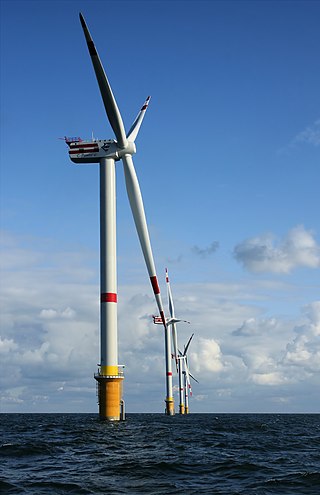
A wind turbine is a device that converts the kinetic energy of wind into electrical energy. As of 2020, hundreds of thousands of large turbines, in installations known as wind farms, were generating over 650 gigawatts of power, with 60 GW added each year. Wind turbines are an increasingly important source of intermittent renewable energy, and are used in many countries to lower energy costs and reduce reliance on fossil fuels. One study claimed that, as of 2009, wind had the "lowest relative greenhouse gas emissions, the least water consumption demands and the most favorable social impacts" compared to photovoltaic, hydro, geothermal, coal and gas energy sources.

BARD Offshore 1 is a 400 megawatt (MW) North Sea offshore wind farm with 80 BARD 5.0 turbines. Since the owner could not buy such 5MW offshore wind turbines in sufficient numbers in 2006, Dr. Bekker set up its own production of turbines. This should serve as the legacy for his children. The systems were developed by aerodyn Energiesysteme GmbH. A plant for rotor blades and nacelle assembly was built in Emden and a plant for the offshore foundations in Cuxhaven. Two turbine prototypes were set up at the Rysumer Nacken in 2007, and another prototype in Hooksiel in 2008. Construction was finished in July 2013 and the wind farm was officially inaugurated in August 2013. The wind farm is located 100 kilometres (60 mi) northwest of the isle Borkum in 40-metre (130 ft) deep water.
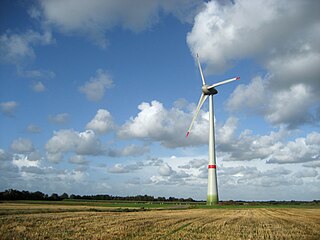
The Enercon E-126 is an onshore wind turbine model manufactured by the German company Enercon. With a hub height of 135 m (443 ft), rotor diameter of 126 m (413 ft) and a total height of 198 m (650 ft), the turbine can generate up to 7.58 megawatts of power, making it the largest wind turbine in the world for several years, until it was overtaken in 2014 by the Danish company Vestas with their V164-8.0 turbine. Their model number is a reference to their rotor diameter.
GE Offshore Wind is a joint venture with Alstom and a subsidiary of GE Vernova, created in 2015 when most of Alstom's electrical power and generation assets were acquired by General Electric. GE's stake in the joint venture is 50% plus 1 share.

GE Wind is a division of GE Vernova. The company manufactures and sells wind turbines to the international market. In 2018, GE Wind was the fourth largest wind turbine manufacturer in the world. Vic Abate is the CEO of GE Vernova’s Wind businesses.
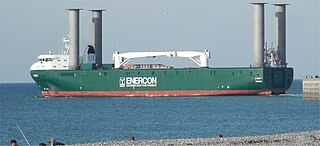
The E-Ship 1 is a roll-on/lift-off (RoLo) cargo ship that made its first voyage with cargo in August 2010. The ship is owned by the third-largest wind turbine manufacturer, Germany's Enercon GmbH. It is used to transport wind turbine components. The E-Ship 1 is a Flettner ship: four large rotorsails that rise from its deck are rotated via a mechanical linkage to the ship's propellers. The sails, or Flettner rotors, aid the ship's propulsion by means of the Magnus effect – the perpendicular force that is exerted on a spinning body moving through a fluid stream.

The Delabole wind farm was the first commercial onshore wind farm built in the United Kingdom, in November 1991. This field of wind turbines was initially developed by Windelectric Management Ltd.

The great majority of wind turbines around the world belong to individuals or corporations who use them to generate electric power or to perform mechanical work. As such, wind turbines are primarily designed to be working devices. However, the large size and height above surroundings of modern industrial wind turbines, combined with their moving rotors, often makes them among the most conspicuous objects in their areas. A few localities have exploited the attention-getting nature of wind turbines by placing them on public display, either with visitor centers on their bases, or with viewing areas farther away. The wind turbines themselves are generally of conventional horizontal-axis, three-bladed design, and generate power to feed electrical grids, but they also serve the unconventional roles of technology demonstration, public relations, and education.
Adwen GmbH is an offshore wind service company headquartered in Bremerhaven, Germany. It is a wholly owned subsidiary of Spanish-German company Siemens Gamesa. Previously the company designed, assembled, and installed 5-Megawatt wind turbines for offshore wind farms. It also designed and manufactured rotor blades through its subsidiary Adwen Blades GmbH, headquartered in Stade, Germany.
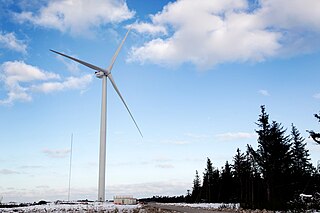
The Vestas V164 is a three-bladed offshore wind turbine, produced by Vestas, with a nameplate capacity of up to 10 megawatts, a world record. Vestas revealed the V164's design in 2011 with the first prototype unit operated at Østerild in northern Denmark in January 2014. The first industrial units were installed in 2016 at Burbo Bank, off the west coast of the United Kingdom. By 2021, Vestas had produced 500 of the series.

Aloys Wobben was a German billionaire businessman, engineer, and the founder and owner of the wind turbine company Enercon. He was one of the 50 richest people in Germany, with a fortune estimated at €4.78 billion, as of November 2020. As of August 2021, Forbes estimated his net worth to be US$7.1 billion.
Seawind Ocean Technology B.V., a Netherlands based company, is a manufacturer (OEM) of integrated floating wind turbine and green hydrogen systems. Seawind is developing two-bladed floating wind turbines suitable for installation in all seas, including hurricane regions and ultra-deep waters. Founded on original research and development work by NASA, Hamilton Standard, Enel, and Aeritalia; Seawind's offshore wind power turbines with integrated foundations have been patented, proven at 1.5 MW, and achieved Type D DNV certification in December 2019. The company is now planning the launch of its Seawind 6 demonstrator to be followed by the pre-series Seawind 12, a project earmarked for installation as early as 2024-25 that seeks to obtain DNV's highest certification level.

































